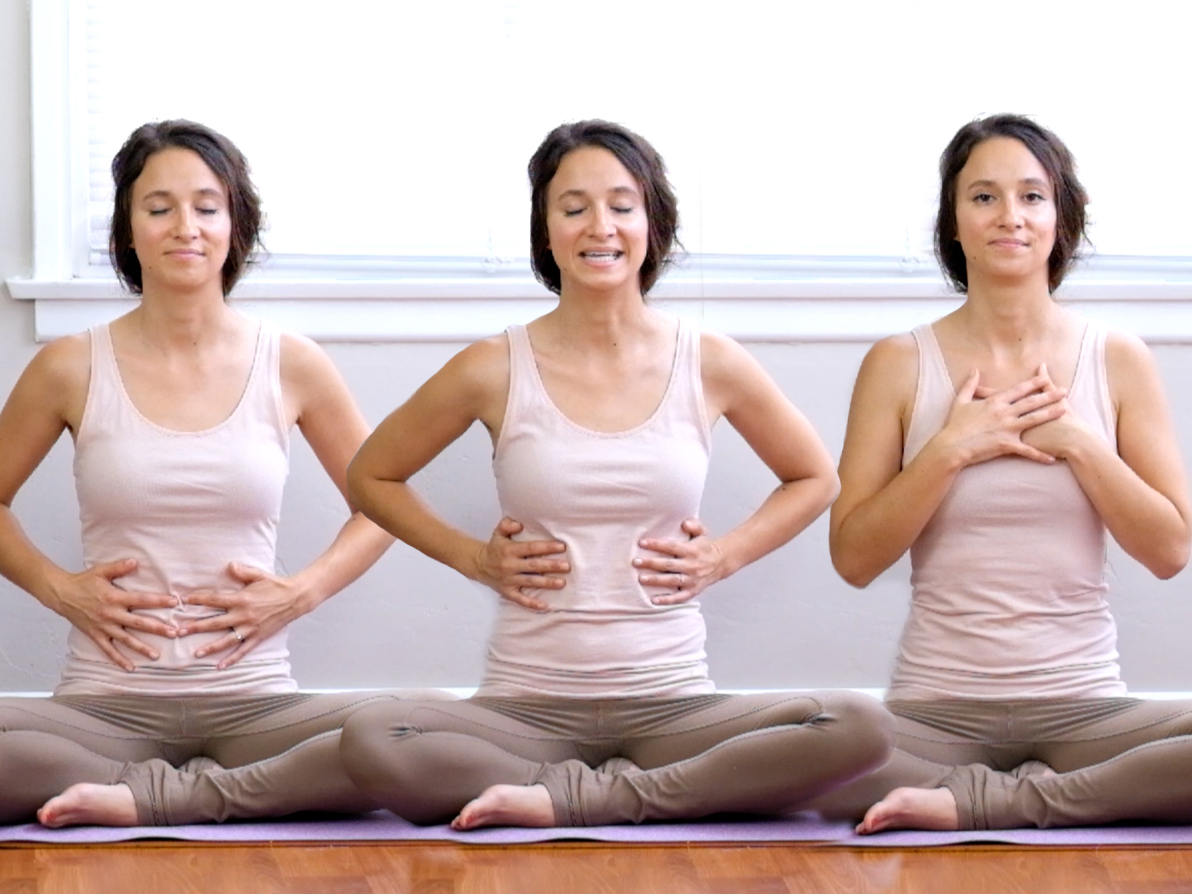Pranayama, or yogic breathing exercises, is wonderful support for respiratory health when done properly. What better time to learn? I’d like to teach you a few simple techniques that can help you stay healthy and prevent disease.
First, a little about breathing in general. Most of us are shallow breathers which creates compromised respiration. We may also be chest breathers and our diaphragm, our primary breathing muscle, becomes underutilized. Basically, we’re not getting enough oxygen when we don’t breathe more deeply and the muscles we use to breathe become weakened. Our circulation of oxygen, blood, and nutrients to our brain and vital organs may slow and stagnate. Our minds may become dull and tired. The breath and how we use it (or not) is directly is connected to our well being.
Shallow chest breathing triggers the Sympathetic Nervous System or a stress response (fight, flight or freeze). Learning how to take full, expansive breaths is the first step in strengthening our breathing muscles and boosting our respiratory health in general.
Three-Part Yogic Breathing (Dirgha Pranayama) is the first breathing exercise I teach all my Ayurveda clients and Yoga students. It is the most important practice that helps us to experience full breathing.
Remember, it’s a practice. It may feel awkward at first. Be gentle and patient with yourself and you’ll be glad you stuck with it. Breathing patterns are not easy to change.
Here’s a short video to help guide you through the exercise.
Setting yourself up
- Find a comfortable seat.
- Sit with an erect and long spine.
- Stack your lower ribs over your hips (make sure they’re not jutting forward or up).
- Stack shoulders over hips and ears over shoulders to create proper alignment in the upper body and spine.
- Check in with your breathing here: what do you feel and where do you feel it?
- There’s no right or wrong as long as you’re comfortable.
- Try to breath in and out of your nostrils. An exhale out of the mouth occasionally can release tension and stress.
Warming up
First Part: Belly Lower your hands to your belly space and see if you can feel the rise and fall of your belly as you breath in and out. If you can, this is your diaphragm moving gently up and down against your abdominal organs with each breath, much like a piston. On an inhale, see if you can feel your diaphragm lowering down. The diaphragm pushes organs down and expands into the belly space. This is belly breathing. Take a few deeper, more expansive breaths here if it’s comfortable. Send breath towards your hands. This exercise on it’s own can be very calming as long as it feels good. It’s a great way to check in when you’re feeling stressed.
If you feel tension, be gentle. Don’t force through resistance; try working with it. Don’t worry if you’re not getting it right away. Just keep awareness on sensing the movement you feel with each breath. You might feel more movement by doing this lying down.
Second Part: Ribs Now, bring your hands to the outer rib cage on each side. Notice if you can feel your ribs moving as you breathe. Take a few deep breaths here if it’s comfortable. Send breath towards your hands. Keep shoulders relaxed.
Third Part: Chest Next, rest your fingertips upon your collar bone. Notice if you can feel your upper chest moving as you breathe. Take a few deeper breaths here if it’s comfortable. Send breath towards your fingertips. Keep arms and shoulders relaxed.
All Together Now
- Finally, you’re goal is to breath into each part, one at a time, in this order starting with the belly on one long inhale.
- Begin by drawing a deep breath in and out.
- On your next inhale breathe into your 1) belly. Pause briefly.
- Next, inhale into your 2) ribs. Pause briefly.
- Finally, inhale into your 3) upper chest. Pause briefly.
- Release with a long, slow exhalation. Try it again when you’re ready.
- Eventually, try seamlessly connecting the parts without the brief pause in between to create a full, flowing inhale. Release with a long, slow exhalation. It’s okay to keep the pause at the top of the inhale before exhaling – if that feels good.
- Try this 3-5 times in the morning and again in the evening. Gradually work up to 10 times.
- After, release the exercise and return to a natural flow of breathing.
- Check in again with your breathing.
- Sit quietly for a few minutes.
Optional: Add Resistance After you’v gotten the hang of this, you can try adding strength training for your breathing muscles and lungs. Do the practice as described above while placing gentle pressure to the outside of your nostrils. More pressure is more of a work out. You’ll really feel all your breathing muscles working. Practice this just a few times to begin and gradually do it for as long as it feels comfortable. I like to close with a few rounds of this before I end my practice. Contraindication: pregnancy.
Yogic Breathing To Prepare For Meditation
Pranayama is a natural way to prepare for a few minutes of meditation – or longer when you’re ready. After doing breathing exercises, simply sit quietly, focus on your breathing and notice the after-effects for as long as it feels comfortable to do so. Notice how you feel. Thoughts and feelings are always okay while sitting in meditation. Just try to find ease among them and see if you can bear your own company for a little while without getting wrapped up in what your mind or heart are doing. Pema Chodron says it’s helpful to label it “thinking” or “feeling” and let it pass without becoming too involved. It might be easier said than done but, that is the practice of meditation in a nutshell.
Yogic Breathing Makes Yoga Postures More Effective Try combining breathing exercises when doing yoga postures or asana for a more effective practice. While holding poses, try 3 to 5 rounds of Three-Part Breathing. Now you’re cooking with gas! You’ll find you can work deeper and longer in poses. Your practice can become more efficient, too. I hope you’ll try it. Keep breathing, friends!
As always, much love from the powerful intersection of Ayurveda & Yoga.
From my heart to yours,
Heather




0 Comments